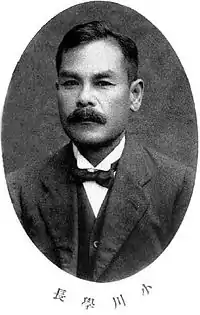Masataka Ogawa | |
|---|---|
 | |
| Born | 21 February 1865 |
| Died | 11 July 1930 (aged 65) |
| Nationality | |
| Scientific career | |
| Fields | Chemistry |
Masataka Ogawa (小川 正孝, Ogawa Masataka, 21 February 1865 – 11 July 1930[1]) was a Japanese chemist mainly known for the claimed discovery of element 43 (later known as technetium), which he named nipponium. In fact, he had discovered, but misidentified, element 75 (later called rhenium).[2][3]
After graduating from the University of Tokyo, he studied under William Ramsay in London, where he worked on the analysis of the rare mineral thorianite. He extracted and isolated a small amount of an apparently unknown substance from the mineral, which he announced as the discovery of element 43, naming the newly discovered element nipponium. He published his results in 1909 and a notice was also published in the Journal of the American Chemical Society.[4] For this work, he was awarded a doctorate and the highest prize of the Tokyo Chemical Society. However, no other researchers were able to replicate his discovery, and the announcement was forgotten.[5]
Ogawa served as president of Tohoku University between 1919 and 1928.[6] While the name nipponium could not be reused for another element, element 113 was also discovered by a team of Japanese scientists and is now named nihonium, also after Japan. The name was chosen in respectful homage to Ogawa's work.[7]
References
- ↑ 幻の元素「ニッポニウム」を発見 小川正孝|日本の世界一
- ↑ Yoshihara, H. K. (2004). "Discovery of a new element 'nipponium': re-evaluation of pioneering works of Masataka Ogawa and his son Eijiro Ogawa". Spectrochimica Acta Part B. 59 (8): 1305–1310. Bibcode:2004AcSpe..59.1305Y. doi:10.1016/j.sab.2003.12.027.
- ↑ Hisamatsu, Yoji; Egashira, Kazuhiro; Maeno, Yoshiteru (2022). "Ogawa's nipponium and its re-assignment to rhenium". Foundations of Chemistry. 24: 15–57. doi:10.1007/s10698-021-09410-x. Retrieved 16 November 2023.
- ↑ Howe, J. S. (1909). "Recent Work in Inorganic Chemistry". Journal of the American Chemical Society. 31 (12): 1284–1305. doi:10.1021/ja01942a006.
- ↑ Kaji, M. "A discovery which served as a foothold". St. Petersburg: Through Centuries. Retrieved 2016-03-11.
- ↑ Tohoku University page
- ↑ Öhrström, Lars; Reedijk, Jan (28 November 2016). "Names and symbols of the elements with atomic numbers 113, 115, 117 and 118 (IUPAC Recommendations 2016)" (PDF). Pure Appl. Chem. 88 (12): 1225–1229. doi:10.1515/pac-2016-0501. hdl:1887/47427. S2CID 99429711. Retrieved 22 April 2017.